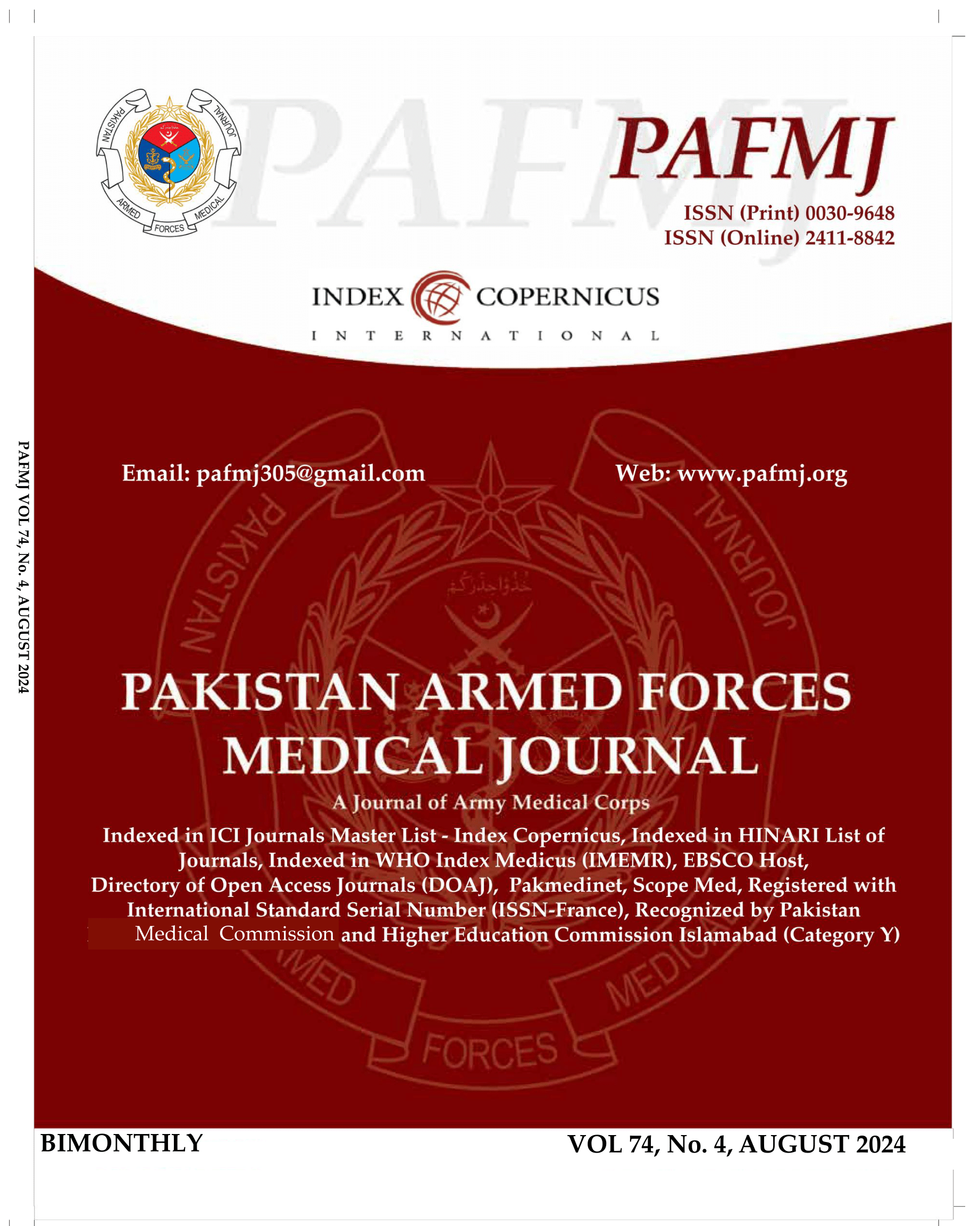Comparison of Levetiracetam and Phenobarbital for Treating Neonatal Seizures Associated with Hypoxic-Ischemic Encephalopathy
DOI:
https://doi.org/10.51253/pafmj.v74i4.7988Keywords:
Hypoxic-ischemic encephalopathy, Levetiracetam, Neonatal seizures, Phenobarbital, Seizures.Abstract
Objective: To compare the effectiveness of Levetiracetam and Phenobarbital for treating neonatal seizures associated with hypoxic-ischemic encephalopathy.
Study Design: Quasi-experimental study.
Place and Duration of the Study: Department of Neonatology, The Children’s Hospital and Institute of Child Health, Multan Pakistan, from Mar to Nov 2021.
Methodology: A total of 132 term neonates of both genders, with birth weight above 1800 grams, presenting within 24 hours of life, with clinical or electric seizures onset secondary to perinatal hypoxia and requiring resuscitation at birth, were included. The neonates were allocated to either Phenobarbital or LEV Group. The efficacy was labelled “yes” if a neonate showed cessation of seizures after the 1st or 2nd dose of the drug and remained seizure-free for the next 24 hours.
Results: Out of 132 neonates, 77(58.3%) were male. The mean age was 8.92±4.22 hours. The mean birth weight was 2.29±0.28 kg, ranging between 1.9 and 3 kg. The mean gestational age was 37.67±0.91 weeks. Cessation of seizures occurred among 43(65.2%) neonates in the PB-Group in comparison to 54(81.8%) in the LEV-Group (p=0.030). Mortality was reported in 7(5.3%) neonates (4 in the PB-Group and 3 in the LEV-Group).
Conclusion: The LEV was found to be more effective than PB as a first-line treatment agent for neonatal seizure associated with hypoxic-ischemic encephalopathy. Therefore, the LEV can be considered a good and safe alternative to PB for treating NS.
Downloads
References
Associated with Neonatal Seizure and its Short-term Outcome: A Retrospective Prognostic Cohort Study. Iran J Child Neurol 2018; 12(3): 59-68.
Kurinczuk JJ, White-Koning M, Badawi N. Epidemiology of neonatal encephalopathy and hypoxic-ischaemic
encephalopathy. Early Hum Dev 2010; 86(6): 329–338.
https://doi.org/10.1016/j.earlhumdev.2010.05.010
Lawn JE, Lee AC, Kinney M, Sibley L, Carlo WA, Paul VK, et al. Two million intrapartum-related stillbirths and neonatal deaths: where, why, and what can be done? Int J Gynaecol Obstet 2009; 107(Suppl 1): S5–18. https://doi.org/10.1016/j.ijgo.2009.07.016
El-Dib M, Soul JS. The use of phenobarbital and other anti-seizure drugs in newborns. Semin Fetal Neonatal Med 2017; 22(5): 321-327. https://doi.org/10.1016/j.siny.2017.07.008
Falsaperla R, Mauceri L, Pavone P, Barbagallo M, Vitaliti G, Ruggieri M, et al. Short-term neurodevelopmental outcome in term neonates treated with phenobarbital versus levetiracetam: a single-center experience. Behav Neurol 2019: 2019: 3683548.
https://doi.org/10.1155/2019/3683548
Silverstein FS, Ferriero DM. Off-label use of antiepileptic drugs for the treatment of neonatal seizures. Pediatr Neurol. 2008; 39(2): 77-79. https://doi.org/10.1016/j.pediatrneurol.2008.04.008
Venkatesan C, Young S, Schapiro M, Thomas C. Levetiracetam for the treatment of seizures in neonatal hypoxic ischemic encephalopathy. J Child Neurol 2017; 32(2): 210-214.
https://doi.org/10.1177/0883073816678102
Arican P, Dundar ON, Atasever MN, Inal AM, Gencpinar P, Cavusoglu D, et al. Comparison of the neurocognitive outcomes in term infants treated with levetiracetam and phenobarbital monotherapy for neonatal clinical seizures. Seizure 2020; 80: 71-74. https://doi.org/10.1016/j.seizure.2020.06.006
Gowda VK, Romana A, Shivanna NH, Benakappa N, Benakappa A. Levetiracetam versus phenobarbitone in neonatal seizures - A randomized controlled trial. Indian Pediatr 2019; 56(8): 643-646.
Qiao MY, Cui HT, Zhao LZ, Miao JK, Chen QX. Efficacy and safety of levetiracetam vs. phenobarbital for neonatal seizures: A systematic review and meta-analysis. Front. Neurol 2021; 12: 747745. https://doi.org/10.3389/fneur.2021.747745
McHugh DC, Lancaster S, Manganas LN. A systematic review of the efficacy of levetiracetam in neonatal seizures.
Neuropediatrics 2018; 49(1): 12-17.
https://doi.org/10.1055/s-0037-1608653
Abend NS, Gutierrez-Colina AM, Monk HM, Dlugos DJ, Clancy RR. Levetiracetam for treatment of neonatal seizures. J Child Neurol 2011; 26(4): 465-470.
https://doi.org/10.1177/0883073810384263
Baudou E, Cances C, Dimeglio C, Hachon Lecamus C. Etiology of neonatal seizures and maintenance therapy use: a 10-year retrospective study at Toulouse Children's hospital. BMC Pediatr 2019; 19(1): 136.
https://doi.org/10.1186/s12887-019-1508-5
Khan MH, Gul SS, Zaman Q, Ahmad N, Qurrat-ul-Ann. Effectiveness of Levetiracetam as a First Line Anticonvulsant for Neonatal Seizures. Med Forum 2021; 32(8): 25-28.
Favrais G, Ursino M, Mouchel C, Boivin E, Jullien V, Zohar S, et al. Levetiracetam optimal dose-finding as first-line treatment for neonatal seizures occurring in the context of hypoxicischaemic encephalopathy (LEVNEONAT-1): study protocol of a phase II trial. BMJ Open 2019; 9(1): e022739.
https://doi.org/10.1136/bmjopen-2018-022739
Sharpe C, Reiner GE, Davis SL, Nespeca M, Gold JJ, Rasmussen M, et al. Levetiracetam versus phenobarbital for neonatal seizures: a randomized controlled trial. Pediatrics 2020; 145(6): e20193182.
https://doi.org/10.1542/peds.2019-3182
Painter MJ, Scher MS, Stein AD, Armatti S, Wang Z, Gardiner JC, et al. Phenobarbital compared with phenytoin for the treatment of neonatal seizures. N Engl J Med 1999 341(7): 485–489.
https://doi.org/10.1056/NEJM199908123410704
Khan O, Chang E, Cipriani C, Wright C, Crisp E, Kirmani B. Use of intravenous levetiracetam for management of acute seizures in neonates. Pediatr Neurol. 2011; 44(4): 265–269.
https://doi.org/10.1016/j.pediatrneurol.2010.11.005
Kim JS, Kondratyev A, Tomita Y, Gale K. Neurodevelopmental impact of antiepileptic drugs and seizures in the immature brain. Epilepsia. 2007; 48(Suppl 5): 19–26.
Downloads
Published
Issue
Section
License
Copyright (c) 2024 Muhammad Khalil Surani, Abdur Rehman Malik, Nazia Fatima, Muhammad Awais Roomi, Ammara Arshad, Aashee Nadeem

This work is licensed under a Creative Commons Attribution-NonCommercial 4.0 International License.















